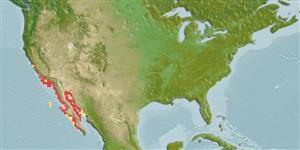Actinopterígios (peces con aletas radiadas) >
Perciformes (Perch-likes) >
Haemulidae (Grunts) > Haemulinae
Etymology: Anisotremus: Greek, anisos = unequal + Greek, trema, -atos = hole (Ref. 45335).
Medioambiente / Clima / Gama
Ecología
; marino demersal; rango de profundidad 0 - 40 m (Ref. 2850), usually ? - 8 m (Ref. 2850). Subtropical, preferred ?; 37°N - 24°N, 124°W - 107°W
Eastern Central Pacific: Santa Cruz in central California, USA to southern Baja California, Mexico; isolated population in the Gulf of California.7
Tamaño / Peso / Age
Maturity: Lm ? range ? - ? cm
Max length : 58.0 cm TL macho / no sexado; (Ref. 2850); edad máxima reportada: 15 años (Ref. 56049)
Occur in coastal waters, frequently in rocky reefs and occasionally over sandy bottoms (Ref. 9114); often near kelp beds. Juveniles form schools in littoral pools (Ref. 9114). Feed on crustaceans, mollusks and bryozoans. Pelagic spawner (Ref. 56049). Marketed fresh (Ref. 9114).
Life cycle and mating behavior
Madurez | Reproducción | Puesta | Huevos | Fecundidad | Larva
Distinct pairing during breeding (Ref. 205). Pelagic spawner (Ref. 56049).
Eschmeyer, W.N., E.S. Herald and H. Hammann, 1983. A field guide to Pacific coast fishes of North America. Boston (MA, USA): Houghton Mifflin Company. xii+336 p. (Ref. 2850)
IUCN Red List Status (Ref. 115185)
CITES (Ref. 94142)
Not Evaluated
Threat to humans
Harmless
Human uses
Pesquerías: escaso valor comercial; pesca deportiva: si
Más información
ReferenciasAcuiculturaPerfil de acuiculturaRazasGenéticaFrecuencias de alelosheritabilidadEnfermedadesProcesamientoMass conversion
ColaboradoresImágenesStamps, CoinsSonidosCiguateraVelocidadTipo de nataciónSuperficie branquialOtolitosCerebrosVisión
Herramientas
Special reports
Download XML
Fuentes de Internet
